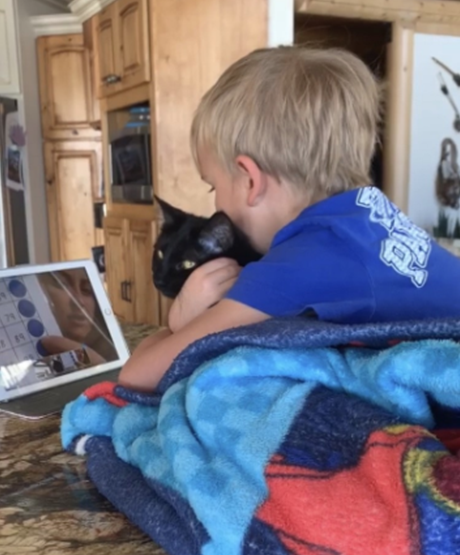Teaching and Learning During COVID-19
CategoriesAs we begin another week at home adjusting to life with the COVID-19 pandemic, it’s heartening to witness the commitment, compassion, and creativity of educators across our nation.
Within my own community, meals were provided by the school district on day one of the school closures. Educators worked hard to connect with families to check-in and answer questions based on the limited information they had.
 During week two of the school closures, Chromebooks were made available for students who didn’t have their own devices to support remote learning (anticipated to begin during week 3). Also provided was information about free and reduced-cost internet resources.
During week two of the school closures, Chromebooks were made available for students who didn’t have their own devices to support remote learning (anticipated to begin during week 3). Also provided was information about free and reduced-cost internet resources.
In this insightful article, “K-12 Learning During a Pandemic: Why We Need to Slow Down for Mental Health’s Sake,” Dr. Elizabeth Farfan-Santos states:
We are in the middle of a global crisis. This is not a time to overwhelm kids (or parents) with worksheets, web-based homeschooling, and the push to stay on track for standardized tests or college prep. This is a time to model compassion. This is a time to make sure our children feel safe and loved, and to make sure families have time to adjust to a new normal.
Safety, relationships, access, learning… As we try to make sense of this strange and unsettling time, I feel so grateful and proud to belong to a district that seems to be focusing on the needs similar to the COVID-19 School Hierarchy of Needs model provided by the COVID-19 Schools Resource Hub.
 However, every school district has varying levels of resources available to support families with varying levels of needs. A teacher in a Facebook group (with over 130,000 members) called “Teaching During COVID-19” shared that a parent wrote to her asking for help because the family's tablet is old and unable to support the apps required for her 2nd grader for online learning.
However, every school district has varying levels of resources available to support families with varying levels of needs. A teacher in a Facebook group (with over 130,000 members) called “Teaching During COVID-19” shared that a parent wrote to her asking for help because the family's tablet is old and unable to support the apps required for her 2nd grader for online learning.
This is an example of the importance of giving students grace and showing empathy if they do not complete assigned work - we don’t know what circumstances and stressors they are facing at home. Perhaps parents have lost their jobs or maybe the family does not have reliable internet service or devices to even access the online learning platforms. Sometimes parents are too embarrassed or ashamed to ask - therefore it's critical to reach out without judgment. This article provides important information for educators about a trauma-informed approach to teaching through Coronavirus.
The creativity and innovation of teachers never ceases to amaze me – especially now. No whiteboard at home? No problem – a math teacher in the Facebook group used her white shower wall to demonstrate algebra equations. Another teacher shared a picture of her student using his white dishwasher as a whiteboard. (I tested this out with dry-erase markers, and it works well – I would recommend erasing in a timely manner to avoid stains, though.)
Another teacher shared an iPhone hack of using the Notes app to scan documents. (So handy!) Other educators provided some levity to our current situation with humorous and relatable memes.
 Educators all over the county are parading through their students’ neighborhoods in their cars to say hello from a safe distance. I watched a teacher conduct his morning meeting using Lego characters to represent each of his students while another teacher did the same using Mii characters. I can imagine the big smiles on their students’ faces.
Educators all over the county are parading through their students’ neighborhoods in their cars to say hello from a safe distance. I watched a teacher conduct his morning meeting using Lego characters to represent each of his students while another teacher did the same using Mii characters. I can imagine the big smiles on their students’ faces.
Research shows students who feel a sense of belonging are more engaged learners. In this article, educators share strategies for maintaining relationships with and among students while we’re all separated in our own physical spaces. Be sure to check out this endearing video message from a first-grade teacher to his students.
Please feel free to join the 130,000+ members (including me) of the “Teaching During COVID-19” Facebook group – you just need to agree to follow the group’s rules and answer a few basic questions. It’s a wonderful place for educators to come together to have conversations, share resources, ask questions, and provide inspiration.
Last week an elementary teacher shared how she is working on setting boundaries by shutting down her laptop at the end of each school day, getting outside for daily walks, and focusing on her own well-being and her family. What a valuable reminder for all educators. As the saying goes, “You can’t pour from an empty cup.”
Thank you for your commitment, compassion, and creativity, educators. Stay well, stay safe.
Here are a few classes related to this topic:
 Collaborative Web Technologies: Transforming Teaching and Learning
Collaborative Web Technologies: Transforming Teaching and Learning
 Technology Tools for the Digital Teacher
Technology Tools for the Digital Teacher
 Teaching Algebra with Technology
Teaching Algebra with Technology